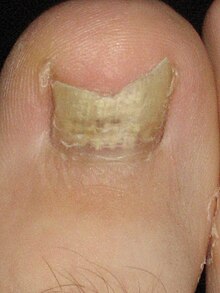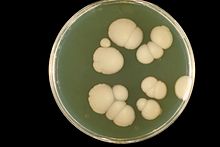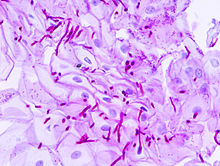More than 20 types of Candida can cause infection with Candida albicans being the most common.[1] Infections of the mouth are most common among children less than one month old, the elderly, and those with weak immune systems. Conditions that result in a weak immune systems include HIV/AIDS, after organ transplantation, diabetes, and the use corticosteroids. Other risks include dentures and following antibiotic therapy.[5] Vaginal infections occur more commonly during pregnancy, in those with weak immune systems, and following antibiotic use.[6] Risk for widespread infection includes being in an intensive care unit, following surgery, low birth weight infants, and those with weak immune systems.[7]
Efforts to prevent infections of the mouth include the use of chlorhexidine mouth wash in those with poor immune function and washing out the mouth following the use of inhaled steroids.[8] In those with frequent vaginal infections probiotics may be useful.[6] For infections of the mouth, treatment with topical clotrimazole or nystatin is usually effective. Oral or intravenous fluconazole, itraconazole, or amphotericin B may be used if these do not work.[8] A number of topical antifungal medications may be used for vaginal infections including clotrimazole.[9] In those with widespread disease, a number of weeks of intravenous amphotericin B is often used.[10] In certain groups at very high risk antifungal medications may be used preventatively.[7]
Infections of the mouth occur in about 6% of babies less than a month old. About 20% of those receiving chemotherapy for cancer and 20% of those with AIDS also develop the disease.[11] About three-quarters of women have at least one yeast infection at some time during their lives.[12] Widespread disease is rare except in those who have risk factors.[13] These diseases are also known technically as candidosis, moniliasis, and oidiomycosis.[14]
Contents
[hide]Signs and symptoms[edit]

Nail candidiasis (onychomycosis)
Candidiasis is a very common cause of vaginal irritation, or vaginitis, and can also occur on the male genitals. In immunocompromised patients, Candida infections can affect the esophagus with the potential of becoming systemic, causing a much more serious condition, a fungemia called candidemia.[18][19]
Thrush is commonly seen in infants. It is not considered abnormal in infants unless it lasts longer than a few weeks.[20]
Infection of the vagina or vulva may cause severe itching, burning, soreness, irritation, and a whitish or whitish-gray cottage cheese-like discharge. These symptoms are also present in the more common bacterial vaginosis.[21] In a 2002 study, only 33% of women who were self-treating for a yeast infection actually had a such an infection, while most had either bacterial vaginosis or a mixed-type infection.[22] Symptoms of infection of the male genitalia (balanitis thrush) include red skin around the head of the penis, swelling, irritation, itchiness and soreness of the head of the penis, thick, lumpy discharge under the foreskin, unpleasant odour, difficulty retracting the foreskin (phimosis), and pain when passing urine or during sex.[23]
Perianal candidiasis can cause pruritis ani. The lesion can be erythematous, papular, or ulcerative in appearance, and it is not considered to be a sexually transmissible disease.[24]
Esophageal candidiasis can cause difficulty swallowing, or less commonly painful swallowing.[25]
Causes[edit]
See also: Candida
Candida yeasts are generally present in healthy humans, particularly on the skin, but their growth is normally limited by the human immune system, by competition of other microorganisms, such as bacteria occupying the same locations in the human body,[26] and in the case of skin, or by the relative dryness of the skin, as Candida requires moisture for growth.[27]C. albicans was isolated from the vaginas of 19% of apparently healthy women, i.e., those who experienced few or no symptoms of infection. External use of detergents or douches or internal disturbances (hormonal or physiological) can perturb the normal vaginal flora, consisting of lactic acid bacteria, such as lactobacilli, and result in an overgrowth of Candida cells, causing symptoms of infection, such as local inflammation.[28] Pregnancy and the use of oral contraceptives have been reported as risk factors.[29] Diabetes mellitus and the use of antibiotics are also linked to increased rates of yeast infections.[29] Diets high in simple carbohydrates have been found to affect rates of oral candidiases,[30] and hormone replacement therapy and infertility treatments may also be predisposing factors.[31] Wearing wet swimwear for long periods of time is also believed to be a risk factor.[32]
A weakened or undeveloped immune system or metabolic illnesses such as diabetes are significant predisposing factors of candidiasis.[33] Diseases or conditions linked to candidiasis include HIV/AIDS, mononucleosis, cancer treatments, steroids, stress, and nutrient deficiency. Almost 15% of people with weakened immune systems develop a systemic illness caused by Candida species.[34] In extreme cases, these superficial infections of the skin or mucous membranes may enter into the bloodstream and cause systemic Candida infections.
In penile candidiasis, the causes include sexual intercourse with an infected individual, low immunity, antibiotics, and diabetes. Male genital yeast infections are less common, and incidences of infection are only a fraction of those in women; however, yeast infection on the penis from direct contact via sexual intercourse with an infected partner is not uncommon.[35]
Candida species are frequently part of the human body's normal oral and intestinal flora. Treatment with antibiotics can lead to eliminating the yeast's natural competitors for resources, and increase the severity of the condition.[36] In the Western Hemisphere, about 75% of females are affected at some time in their lives.
Diagnosis[edit]

Agar plate culture of C. albicans

KOH test on a vaginal wet mount, showing slings of pseudohyphae of Candida albicans surrounded by round vaginal epithelial cells, conferring a diagnosis of candidal vulvovaginitis
For the culturing method, a sterile swab is rubbed on the infected skin surface. The swab is then streaked on a culture medium. The culture is incubated at 37 °C for several days, to allow development of yeast or bacterial colonies. The characteristics (such as morphology and colour) of the colonies may allow initial diagnosis of the organism causing disease symptoms.[37]
Classification[edit]
Candidiasis may be divided into these types:[14]- Mucosal candidiasis
- Oral candidiasis (thrush, oropharyngeal candidiasis)
- Pseudomembranous candidiasis
- Erythematous candidiasis
- Hyperplastic candidiasis
- Denture-related stomatitis — Candida organisms are involved in about 90% of cases
- Angular stomatitis — Candida species are responsible for about 20% of cases, mixed infection of C. albicans and Staphylococcus aureus for about 60% of cases.
- Median rhomboid glossitis
- Candidal vulvovaginitis (vaginal yeast infection)
- Candidal balanitis, infection of the glans penis, almost exclusively occurring in uncircumcised males[38]
- Esophageal candidiasis (candidal esophagitis)[25]
- Oral candidiasis (thrush, oropharyngeal candidiasis)
- Cutaneous candidiasis
- Onychomycosis (nail infection) caused by Candida[39]
- Invasive candidiasis
- Systemic candidiasis (one organ system involved)
- Disseminated candidiasis (multiple system involvement, e.g. "hepatosplenic candidiasis", which sometimes follows neutropenia; or "candidemia", a form of septicemia).[40] Ultrasound of liver shows wheel inside wheel sign (a central hypoechoic area (necrosis containing fungi) surrounded by an echogenic zone (inflammatory cells).
- Antibiotic candidiasis (iatrogenic candidiasis)
Treatment[edit]
Candidiasis is commonly treated with antimycotics; these antifungal drugs include topical clotrimazole, topical nystatin, fluconazole, and topical ketoconazole.Localized infection[edit]
A one-time dose of fluconazole is 90% effective in treating a vaginal yeast infection.[41] Local treatment may include vaginal suppositories or medicated douches. Other types of yeast infections require different dosing. Gentian violet can be used for thrush in breastfeeding babies. C. albicans can develop resistance to fluconazole, this being more of an issue in those with HIV/AIDS who are often treated with multiple courses of fluconazole for recurrent oral infections.[42]For vaginal yeast infection in pregnancy, topical imidazole or triazole antifungals are considered the therapy of choice owing to available safety data.[43] Systemic absorption of these topical formulations is minimal, posing little risk of transplacental transfer.[43] In vaginal yeast infection in pregnancy, treatment with topical azole antifungals is recommended for 7 days instead of a shorter duration.[43]
Not enough evidence is available to determine if probiotics, either as pills or as yogurt, have an effect on the rate of occurrence of vaginal yeast infections.[44] No benefit has been found for active infections.[45]
Blood infection[edit]
In candidal infections of the blood, intravenous fluconazole or an echinocandin such as caspofungin may be used.[46] Amphotericin B is another option.[46]Prognosis[edit]
Among individuals being treated in intensive care units, the mortality rate is about 30-50% when systemic candidiasis develops.[47]Epidemiology[edit]
Oral candidiasis is the most common fungal infection of the mouth,[48] and it also represents the most common opportunistic oral infection in humans.[49]Esophageal candidiasis is the most common esophageal infection in persons with AIDS, and accounts for about 50% of all esophageal infections, often coexisting with other esophageal diseases. About two-thirds of people with AIDS and esophageal candidiasis also have oral candidiasis.[25]
Candidal sepsis is rare.[50]
History[edit]
Descriptions of what sounds like oral thrush go back to the time of Hippocrates circa 460 - 370 BCE.[15]Vulvovaginal candidiasis was first described in 1849 by Wilkinson.[51] In 1875, Haussmann demonstrated the causative organism in both vulvovaginal and oral candidiasis is the same.[51]
With the advent of antibiotics following World War II, the rates of candidiasis increased. The incidence fell once more in the 1950s following the development of nystatin.[52]
The colloquial term "thrush" refers to the resemblance of the white flecks present in some forms of candidiasis (e.g. pseudomembranous candidiasis) with the breast of the bird of the same name.[53] The term candidosis is largely used in British English, and candidiasis in American English.[51] Candida is also pronounced differently, in American English, the stress is on the "i", whereas in British English the stress is on the first syllable.
The genus Candida and species C. albicans were described by botanist Christine Marie Berkhout in her doctoral thesis at the University of Utrecht in 1923. Over the years, the classification of the genera and species has evolved. Obsolete names for this genus include Mycotorula and Torulopsis. The species has also been known in the past as Monilia albicans and Oidium albicans. The current classification is nomen conservandum, which means the name is authorized for use by the International Botanical Congress (IBC).[54]
The genus Candida includes about 150 different species; however, only a few are known to cause human infections. C. albicans is the most significant pathogenic species. Other species pathogenic in humans include C. tropicalis, C. glabrata, C. krusei, C. parapsilosis, C. dubliniensis, and C. lusitaniae.
The name Candida was proposed by Berkhout. It is from the Latin word toga candida, referring to the white toga (robe) worn by candidates for the Senate of the ancient Roman republic.[51] The specific epithet albicans also comes from Latin, albicare meaning "to whiten".[51] These names refer to the generally white appearance of Candida species when cultured.
Alternative medicine[edit]
What has been described as "a large pseudoscientific cult"[55] has developed around the topic of Candida, with claims up to one in three people are affected by conditions with terms such as systemic candidiasis, "candidiasis hypersensitivity", fungal type dysbiosis, Candida-related complex, the yeast syndrome, yeast allergy, yeast overgrowth, or simply "Candida" or "yeast problem".[56] Some practitioners of alternative medicine have promoted these purported conditions and sold dietary supplements as supposed cures; a number of them have been prosecuted.[57][58]In 1990, alternative health vendor Nature's Way signed an FTC consent agreement not to misrepresent in advertising any self-diagnostic test concerning yeast conditions or to make any unsubstantiated representation concerning any food or supplement's ability to control yeast conditions, with a fine of $30,000 payable to the National Institutes of Health for research in genuine candidiasis.[58]
References[edit]
- ^ Jump up to: a b c d "Candidiasis". cdc.gov. February 13, 2014. Retrieved 28 December 2014.
- ^ Jump up to: a b c "Symptoms of Oral Candidiasis". cdc.gov. February 13, 2014. Retrieved 28 December 2014.
- Jump up ^ "Symptoms of Genital / Vulvovaginal Candidiasis". cdc.gov. February 13, 2014. Retrieved 28 December 2014.
- Jump up ^ "Symptoms of Invasive Candidiasis". cdc.gov. February 13, 2014. Retrieved 28 December 2014.
- Jump up ^ "Risk & Prevention". cdc.gov. February 13, 2014. Retrieved 28 December 2014.
- ^ Jump up to: a b "People at Risk for Genital / Vulvovaginal Candidiasis". cdc.gov. February 13, 2014. Retrieved 28 December 2014.
- ^ Jump up to: a b "People at Risk for Invasive Candidiasis". cdc.gov. February 13, 2014. Retrieved 28 December 2014.
- ^ Jump up to: a b "Treatment & Outcomes of Oral Candidiasis". cdc.gov. February 13, 2014. Retrieved 28 December 2014.
- Jump up ^ "Treatment & Outcomes of Genital / Vulvovaginal Candidiasis". cdc.gov. February 13, 2014. Retrieved 28 December 2014.
- Jump up ^ "Treatment & Outcomes of Invasive Candidiasis". cdc.gov. February 13, 2014. Retrieved 28 December 2014.
- Jump up ^ "Oral Candidiasis Statistics". cdc.gov. February 13, 2014. Retrieved 28 December 2014.
- Jump up ^ "Genital / vulvovaginal candidiasis (VVC)". cdc.gov. February 13, 2014. Retrieved 28 December 2014.
- Jump up ^ "Invasive Candidiasis Statistics". cdc.gov. February 13, 2014. Retrieved 28 December 2014.
- ^ Jump up to: a b James, William D.; Berger, Timothy G.; et al. (2006). Andrews' Diseases of the Skin: clinical Dermatology. Saunders Elsevier. pp. 308–311. ISBN 0-7216-2921-0.
- ^ Jump up to: a b Dolin, [edited by] Gerald L. Mandell, John E. Bennett, Raphael (2010). Mandell, Douglas, and Bennett's principles and practice of infectious diseases (7th ed.). Philadelphia, PA: Churchill Livingstone/Elsevier. pp. Chapter 250. ISBN 978-0-443-06839-3.
- Jump up ^ Corno F.; Caldart M.; Toppino M.; Tapparo A.; Capozzi MP.; Goitre M.; Forte M.; Forcheri V.; Cervetti O (1989-11-15). "[Ano-rectal candidiasis.] [La candidosi ano-rettale.]". PubMed/MEDLINE (in English [Original Article in Italian]). National Library of Medicine: Minerva Chirurgica. p. 1. Archived from the original on 1989 Nov. 15;44(21):2251-3. Retrieved 30 January 2015. Check date values in:
|archivedate=(help) - Jump up ^ Walsh TJ, Dixon DM (1996). "Deep Mycoses". In Baron S et al. eds. Baron's Medical Microbiology (4th ed.). Univ of Texas Medical Branch. ISBN 0-9631172-1-1.
- Jump up ^ Fidel PL (2002). "Immunity to Candida". Oral Dis. 8: 69–75. doi:10.1034/j.1601-0825.2002.00015.x. PMID 12164664.
- Jump up ^ Pappas PG (2006). "Invasive candidiasis". Infect. Dis. Clin. North Am. 20 (3): 485–506. doi:10.1016/j.idc.2006.07.004. PMID 16984866.
- Jump up ^ "Thrush". 2011. Retrieved 2011-04-08.
- Jump up ^ Terri Warren, RN (2010). "Is It a Yeast Infection?". Retrieved 2011-02-23.
- Jump up ^ Ferris DG, Nyirjesy P, Sobel JD, Soper D, Pavletic A, Litaker MS (March 2002). "Over-the-counter antifungal drug misuse associated with patient-diagnosed vulvovaginal candidiasis". Obstetrics and Gynecology 99 (3): 419–425. doi:10.1016/S0029-7844(01)01759-8. PMID 11864668.
- Jump up ^ NHS: Symptoms of thrush in men (balanitis thrush)
- Jump up ^ Bruce G. Wolff et al., ed. (2007). The ASCRS textbook of colon and rectal surgery. New York: Springer. pp. 241, 242, 245. ISBN 0-387-24846-3.
- ^ Jump up to: a b c Yamada T, Alpers DH et al. (2009). Textbook of gastroenterology (5th ed.). Chichester, West Sussex: Blackwell Pub. p. 814. ISBN 978-1-4051-6911-0.
- Jump up ^ Mulley, A. G.; Goroll, A. H. (2006). Primary Care Medicine: office evaluation and management of the adult patient. Philadelphia: Wolters Kluwer Health. pp. 802–3. ISBN 0-7817-7456-X. Retrieved 2008-11-23.
- Jump up ^ Goehring, Richard V. (2008). Mims' medical microbiology. (4th ed. ed.). Philadelphia, PA: Mosby Elsevier. p. 656. ISBN 978-0-323-04475-2.
- Jump up ^ Mårdh PA, Novikova N, Stukalova E (October 2003). "Colonisation of extragenital sites by Candida in women with recurrent vulvovaginal candidosis". BJOG 110 (10): 934–7. doi:10.1111/j.1471-0528.2003.01445.x. PMID 14550364.
- ^ Jump up to: a b Schiefer HG (1997). "Mycoses of the urogenital tract". Mycoses 40 (Suppl 2): 33–6. doi:10.1111/j.1439-0507.1997.tb00561.x. PMID 9476502.
- Jump up ^ Akpan A, Morgan R (August 2002). "Oral candidiasis". Postgraduate Medical Journal 78 (922): 455–9. doi:10.1136/pmj.78.922.455. PMC 1742467. PMID 12185216.
- Jump up ^ Nwokolo NC, Boag FC (May 2000). "Chronic vaginal candidiasis. Management in the postmenopausal patient". Drugs Aging 16 (5): 335–9. doi:10.2165/00002512-200016050-00003. PMID 10917071.
- Jump up ^ MedlinePlus Encyclopedia Vaginal yeast infection
- Jump up ^ Odds FC (1987). "Candida infections: an overview". Crit. Rev. Microbiol. 15 (1): 1–5. doi:10.3109/10408418709104444. PMID 3319417.


No comments:
Post a Comment